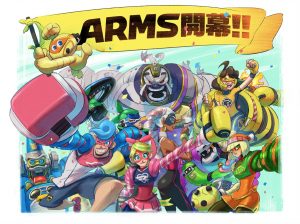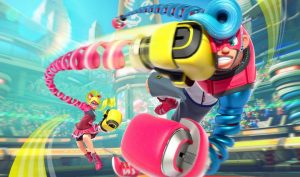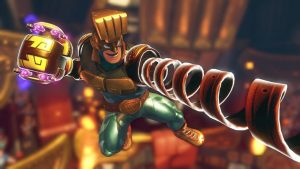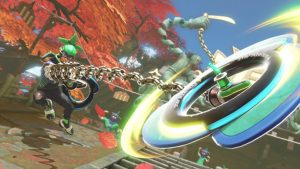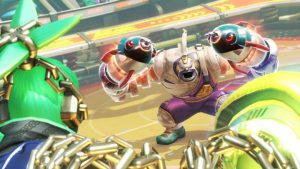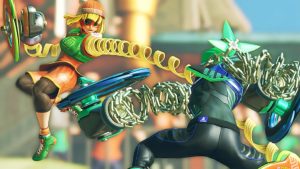ARMS Review


| Game Name: | Arms |
| Platforms: | Nintendo Switch |
| Publisher(s): | Nintendo |
| Developer(s): | Nintendo’s EPD |
| Genre(s): | fighting |
| Release Date: | June 16, 2017 |
| ESRB Rating: | E |
Developed by Nintendo’s EPD division and produced by Mario Kart 8 director Kosuke Yabuki, ARMS does exactly what it says on the tin as a fun-for-all, multiplayer fighting game exclusive to the Switch. Featuring six different modes and ten highly versatile and distinctive fighters, Nintendo’s new IP is what the British would dub “marmite”; you either get it, love it and cuddle it with glee, or you don’t. Just like the ten arenas on show, there’s no neutral ground to duck and dive into, no need to memorise unique combat movement strings, it’s a 1-2 punch, block and pummel set and forget routine. Pick your character, select from three different ARMS on your left and right sides, and begin with or without motion controls. Some might say it’s as easy as 1-2-3.
Between the colourful character selection and the arenas on show, there’s a fighter for every play style out there. From Ribbon Girl’s midair multi-jump or Ninjara’s blink-and-you’ll-miss-it warp and dash technique, to Mechanica’s chunky metal exterior and Helix’s shrink-and-stretch move that blends Ghostbusters with Hasbro’s horrendously weird Stretch Armstrong from the ’70s, ARMS is certainly unique. Each fighter not only looks different but feels distinctive in weight class, overall handling and ARMS technique. According to Nintendo, there’s up to 9,000 possible ARMS combinations to choose from, each with their own elemental typing, a staggering number to showcase the depth of fighter customisation available.
Even choosing which controller to use becomes distinct to your play style. Should you want highly precise, responsive punches you’ll want to play with motion control with a pair of Joy-Cons in each hand. Simply resume the thumbs upright Joy-Con position and use the L, R and ZR buttons to jump, dash and unleash your special, as well as throw both arms out to grab an opponent or bring them close to your chest to guard. But if you want smooth control and the ability to direct your punches with or without a curve, using the Pro Controller or Joy-Con grip is the best option. Guarding, however, is more tricky here and without the ability to map your buttons, it’s a sticking issue for fans of the fighting genre for sure. Even playing ARMS in undocked mode with the Joy-Cons attached can be finicky, although the graphics and its overall playability on the Switch itself is superb.
Although ARMS relies heavily on its online ranked and party match modes, single players can learn the basics – outside of the short tutorial – in Grand Prix mode. With up to ten difficulty settings available, you’ll need to fight ten “best of three” matches in standard PvP combat to secure victory. Should you fail to defeat the CPU, you can always take them on in a rematch or quit partway through to automatically save your progress and pick up where you left off. There’s also the option to play Grand Prix mode as a pair in co-operative play, with an extra CPU player added to balance the fight. You’ll be linked together with a transparent coloured rope though, so if one player gets grabbed and thrown, the other will suffer the consequences. A neat feature aimed to give matches a touch of flourish and embellishment.
After winning each battle, you’ll be awarded a set number of ARMS “medals”, depending on the difficulty level chosen. Collecting this in-game currency – which is awarded after every battle, no matter the mode – serves as a way to unlock new ARMS sets. But unlike other games, you can’t purchase these upgrades; instead players will need to tackle a timed arcade mini-game named Skillshot to claim their prize. With 27 additional ARMS sets on offer, which excludes the three unlocked by default, each character must unlock these separately in order to equip them in battle. For the completionists out there, that’s a whopping 270 sets you’ll need to break the ARMS bank for. And while you can substitute your medals for either 30, 100 or 200 seconds in the mini-game, there’s no guarantee you’ll get an ARMS set each time, let alone the one you actually want due to its random selection. It’s a real risk versus reward scheme that doesn’t fully pay off, leaving the player deflated with a sour taste in the mouth for the game’s only unlockable features.
Since ARMS can be played with up to four people in Versus mode, there’s some great multiplayer action to be had in either the standard PvP fight or team matches, V-Ball, Skillshot and Hoops. While V-Ball is certainly the weakest mini-game as it doesn’t require interaction between players as a standard Volleyball game, Skillshot and Hoops are much more lucrative offerings. Both require more skill and accuracy, with Skillshot requiring you to rack up points by hitting multiple targets while counter-attacking your opponent, alongside the slam-dunk basketball, grab and score affair of Hoops. It’s a shame there’s only one way to score in Hoops with the grab technique, however, and even then your character might miss the basket.
Alongside these mini-games, players will find the 1-on-100, ARMS test and training areas in Versus mode. In 1-on-100, you’ll have to fight 100 Helix-style enemies with health and special regeneration tubes placed strategically throughout the survival mode. While in ARMS test and training, players can try out different ARMS and hone their skills in the various arenas. Their inclusion as mini-games broaden ARMS’ scope and playability, with each being well developed in their own right.
The crux of ARMS’ gameplay lies in its online modes. With Party Match and Ranked Match modes available, it’s easy to spend hours tucked into the game’s lobbies with its smooth player versus player match transitions, which guarantees a match-up within a few minutes, and its target practice warm-up mode for any downtime experienced. Although you won’t be able to specify regional matches, instead you’ll be placed in a random global lobby, you can change your fighter at any time before or after matches without exiting.
Party mode’s box-of-chocolates selection means matches are chosen entirely at random, depending on how many players are frequenting the lobby. From standard PvP matches, V-Ball, Hoops and Skillshot to three versus one boss fights, there’s a good variety on offer to keep ARMS from becoming too limp. Connection lags and time-outs, although minimal, still plague the lobbies. Perhaps it boils down to the unfortunate left Joy-Con de-sync issue, having had trouble on more than one occasion personally. And even though you can play co-operative in the online lobbies, you’ll have to take it in turns to fight in battles instead of playing together. A sure-fire misstep from Nintendo.
Other modes on offer include Friend, Local and Ranked Match. For the latter, you’ll have to win a Grand Prix on difficulty level 4 or higher to unlock the mode, separating the wheat from the chaff. There’s also no health, special regeneration power-ups or bombs in this mode, so you’ll be playing against others on skill alone. It’s a mode with real challenge involved, but you’ll have plenty of chance to level up your rank each time you defeat an opponent. And though it does take a while to match up with another ranked player, you’ll be able to play either Grand Prix or Versus mode while you wait, giving you something else to do than twiddle your thumbs in another warm-up mode.
ARMS truly shines in its party match-ups and versus modes, but it’s let down by a lack of online customisation options and diluted single player offerings which risk becoming repetitive over time. If you’re a fan of multiplayer fighters and prefer the comprehensive combat from Pokken Tournament, Street Fighter and Tekken, ARMS may feel too simplistic with its combat mechanics. But it doesn’t stop us hopping from limb to limb as a back to basics fighting game, albeit with a unique twist.
Game 2 Gamer’s Final Score : 4.5
Replay Level : High




